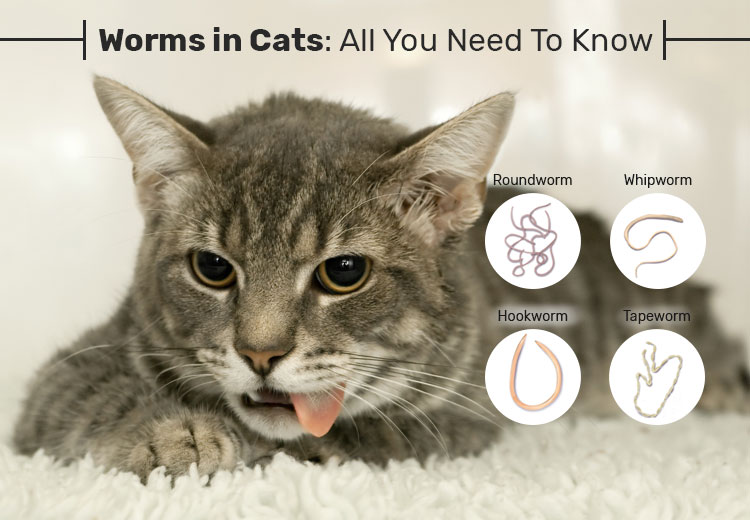

X Research source Interpretation of Laboratory Results for Small Animal Clinicians. An adult hookworm is likewise tiny, measuring a mere two to three millimeters long, and therefore also difficult to detect. Hookworm eggs are also too small to see.X Research source Small Animal Internal Medicine. An adult roundworm is usually just three to six inches long. Roundworms look like spaghetti: long and smooth and about the same diameter as a strand of pasta. A cat infected with hookworm will have an unhealthy. Other symptoms that may present include dark and tarry stool, diarrhea, and constipation. If hookworm larvae gets into the lungs through ingestion, there may be coughing. Roundworm eggs are too small to see with the naked eye, but sometimes whole worms do pass out in the feces, or may even be vomited up. Early symptoms include lesions on the bottoms of the feet and in between the toes, where the hookworm has entered the skin.An adult tapeworm can reach about two feet (60 centimeters) in length. It is unusual to see a whole tapeworm in cat feces, but they look like flat, cream-colored worms made up of many segments.These look like sesame or cucumber seeds, and sometimes wriggle and move. Tapeworms may leave egg packets stuck to the surface of the stool.If an infected person poops outside or their poop is spread outside later, those hookworm eggs end up in the soil. Put on some disposable plastic gloves and use a disposable tool such as a popsicle stick to examine feces in the litter box for signs of parasites. When people have a hookworm infection, their poop will have hookworm eggs in it. The larvae can be found in your kitty's feces, so if you have contact with the feces, you can get hookworm. These worms from your cat can get into human bodies from the infectious larvae of the worm. Technically, hookworms are a type of roundworms.

and with a little knowledge, it's also easy to determine if your cat might have worms.Ĭheck for eggs in the cat's feces. braziliense) are parasites similar to roundworms. Getting rid of worms is relatively easy with the correct worming medication, X Research source Parasites of domestic owned cats: co-infestations and risk factors. Untreated, worms can cause symptoms such as a dull coat or a potbelly, but it is rare they make a cat seriously unwell.

Puppies and kittens can become very unwell with round worm infestation, they can. Because it is relatively easy for a cat to acquire worms, it is a good idea to know the warning signs so you can seek veterinary treatment for the problem early on. Adult dogs and cats with intestinal round worms often do not have any symptoms. Kittens often pick up worms from the mother in her milk, while adult cats pick up worms by accidentally eating worm eggs or eating vermin infested with worms. X Research source Parasites of domestic owned cats: co-infestations and risk factors. Dog health needs to be more fully addressed as part of the Australian Government's commitments to “closing the gap” in chronic disease between Indigenous and other Australians, and encouraging tourism in similar locations.Whether they live exclusively indoors or spend time outside, pet cats may become host to internal parasites such as roundworms, tapeworms, and hookworms. Our results contribute to the understanding of dogs as a public health risk to Indigenous communities and tourists in the Wet Tropics. Its eggs are ejected into the digestive tract and pass into the environment through your dog’s feces. The hookworm attaches to the lining of the intestinal wall and feeds on your dog’s blood. ceylanicum was present in soil samples from two out of the three popular tourist locations sampled. Similar to tapeworms and roundworms, hookworms are intestinal parasites that live in the digestive system of your dog (or cat). ceylanicum infection in domestic dogs (21.7%) and soil (55.6%) in an Indigenous community. We also observed, for the first time, the presence of A. By combining PCR-based techniques with traditional methods of hookworm species identification, we found the prevalence of hookworm in Indigenous community dogs was high (96.3% and 91.9% from necropsy and faecal samples, respectively). ceylanicum in soil and free-ranging domestic dogs at six rainforest locations in Far North Queensland that are Indigenous Australian communities and popular tourist attractions within the Wet Tropics World Heritage Area. Ancylostoma ceylanicum is the common hookworm of domestic dogs and cats throughout Asia, and is an emerging but little understood public health risk in tropical northern Australia.


 0 kommentar(er)
0 kommentar(er)
